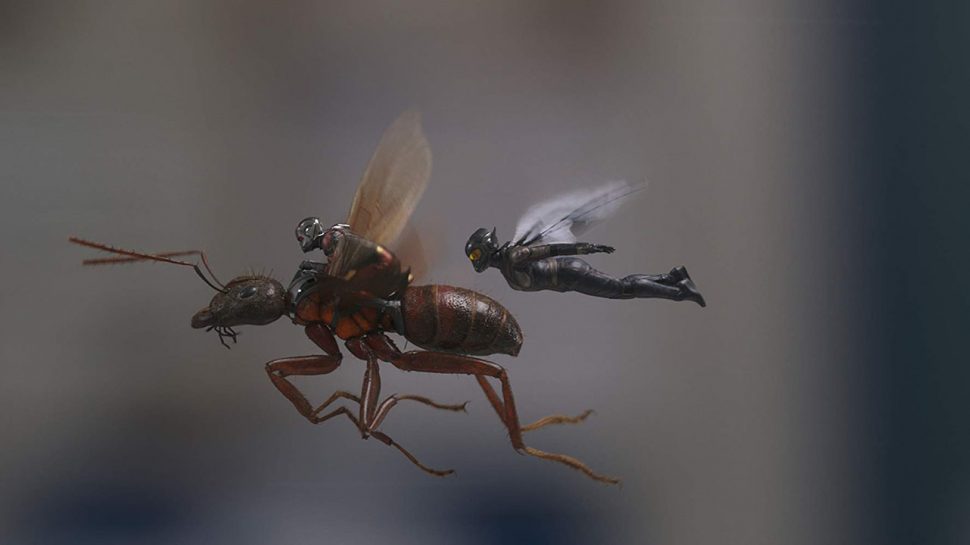As far as films of the Marvel Cinematic Universe go, “Ant-Man and the Wasp” and its predecessor are clear outliers. It emphasises its comedy in a way the other entries do not so that the quips and asides that usually mark their margins become the focus. Beyond its comedic inclinations, though, as a franchise the antics of Ant-Man tend to be more micro than macro-based. And that’s not just a size quip. The stakes and antics of “Ant-Man and the Wasp” are emphatically small-scale. There are no concerns about the fate of the world, or even a city under siege. Instead, the film focuses on interpersonal human interactions and its concerns are almost always the minutiae. For all the peripheral things which threaten the journey the film takes, this small-scale concern becomes it biggest asset.
The central story is as slight as it is straight forward. In the last film, petty criminal turned superhero Scott Lang managed to enter and return from the subatomic quantum realm in his ant-sized state. This revelation is key because years ago Janet van Dyne, the wife of Scott’s mentor Hank Pym, became trapped there. Now, Pym and his daughter have found a way a tunnel to the quantum realm and need Lang’s help to locate Janet. That’s the film. There are other subplots running parallel to and perpendicular to it, but they all end up reacting to that main story. It’s as straightforward and localised a focus for a Marvel film as any and so instead of being a film about the trials or limits of superheroism, “Ant-Man and the Wasp” becomes something else.
Thematically, the film functions best as the story of a triad of father-daughter relationships, which exist in relation to each other. There is the central relationship between Lang and his daughter, Cassie. She’s not afforded as much to do as in the first film, but their relationship is a key part of Lang’s motivational arc. Lang is under house arrest for superhero-related actions from “Captain America: Civil War” and his superhero ennui is more about his debate on how to be a good father. The rumination on parenthood is reflected and then refracted by the relationship between Pym and his daughter Hope (The Wasp). Michelle Pfeiffer appears in too little of the film to do much with Janet, so it is the Hope/Hank dynamic that argues for the ways that a parent and child can work together in achieving a goal. That pairing is further muddied by the third duo, and the film’s most compelling–and equally frustrating—one. For it centres on the film’s primary antagonist. Ava Starr, a woman struggling with chronic pain, exists in the guise of the mystical “Ghost,” who can phase through objects. The way her story intersects with Hank Pym’s and the revelation of how her mentor (a replacement for her dead father) comes to take on a fatherly role is the greatest chance for nuance the film has and it succeeds even as it fumbles with it. Marvel films, as symptomatic of Hollywood’s commercial output, have not been especially incisive about race (even with “Black Panther” in the mix). Ava’s role as a mixed-race character who has been failed by science and the system of white protagonists suggests deeper and more knotty plot points than “Ant-Man and the Wasp” is willing to examine. And that makes sense for, as I pointed out, “Ant-Man and the Wasp” is aiming for the laughs. There is nothing about Ava’s role within the film that is humorous. This is not a Loki-esque villain with risible moments to provoke our amusement. Instead, Ava’s presence shatters the comedy of the film in a way that is both informative and perplexing.
The film seems both better off and worse off for it.
It’s why, despite the triad of parent-child relationships serving as the film’s thematic fulcrum, it’s the peripheral moments, which depend on the comedy, where the film is at its surest. With so many things going on plot-wise, there is less room for Michael Peña’s Luis as Lang’s partner in crime and business but his auxiliary role is still the most surefooted performance in the film. Even as the set-up for Luis’ comedic antics are mildly exasperating, Peña is consistently hilarious and charming in his delivery. It’s impressive work that betrays Peyton Reed’s comedic sensibilities as does Randall Park’s comedic turn in a throwaway role that the film is nonetheless enamoured with.
At its best, “Ant-Man and the Wasp” benefits from how its two hour run-time seems to fly by. At its worst, it could stand to be more thoughtful on race and disability, like many major studio releases. But it’s an incredibly agreeable thing as it ambles along. It’s hard to complain about its slightness and lack of incisiveness when it never really argues for that responsibility in the first place. In the realm of Marvel heroes, Ant-Man is a minor one and this sequel seems content to hold fast to that ideology. “Ant-Man” is a pleasant song in a minor key
(Email your questions, or comments, to Andrew at almasydk@gmail.com.)
Ant-Man and the Wasp is currently showing at Caribbean Cinemas and Princess Movie Theaters Guyana.
Photo saved as Antman5
Caption:

